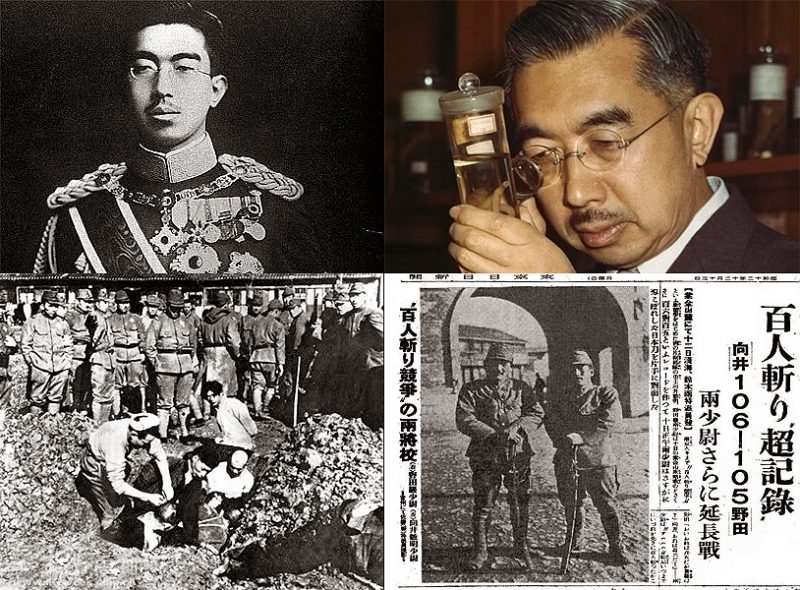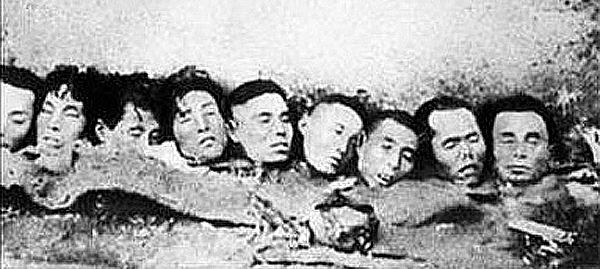Photo story (Clockwise from top left): (1) Japanese emperor Hirohito in his early years as emperor (2) Hirohito was very interested in marine biology and his palace contained a laboratory (3) Toshiaki Mukai and Tsuyosi Noda, the two Japanese soldiers were competing to see who of them could kill one hundred people first with a sword, the headline reads “Incredible record”. The two officers were later executed on war crime charges (4) Chinese prisoners being buried alive during the Nanking Massacre in 1937.
Japanese war atrocities during the second Sino-Japanese War (7th July 1937 to 9th September 1945) and the WWII (1st September 1939 to 2nd September 1945) are often described as the Asian Holocaust. Between 1937 and 1945, nearly 3 to over 10 million people were murdered by Japanese military among which 6 million were Chinese. Others included Koreans, Indonesians, Indochinese, Filipinos and western prisoners of war. Chinese Officials puts the figure including Chinese military and civilians at over 20 million dead and 15 million more wounded.
4,100,000 Japanese soldiers and their 900,000 Chinese collaborators participated in the invasion of China. The Chinese forces defended with 5,600,000 soldiers. Soviets also supported China with 3,600 soldiers till 1940 and US with 900 aircraft between 1942 and 1945. Estimated 1,440,000 Chinese soldiers were killed or missing in action and as high as 22,000,000 Chinese civilians were killed. Japanese sources estimated that 480,000 Japanese soldiers were killed in action while the Chinese studies estimated 1,055,000 Japanese soldiers were killed in action.
Photo story: (5) Severed heads of Nanking massacre victims in 1937-38
Governments and historians of a number of countries hold Imperial Japanese family, especially Emperor Hirohito, Imperial Japanese Army and Imperial Japanese Navy responsible for the mass murder and other war crimes committed against millions of prisoners and civilians of war. Many Japanese soldiers admitted committing the cold blooded war crimes.
Due to absence of specific international humanitarian laws to prohibit unlawful aerial conducts before the WWII, Japanese Airmen of the Imperial Japanese Navy Air Service and Imperial Japanese Army Air Service were spared from including in the list of perpetrators. However, Japanese Air Services participated in biological and chemical attacks which were prohibited in the 1899 and 1907 Hague Conventions’ agreements signed also by Japan.
Japanese war crimes include crimes against enemy soldiers, civilians, prisoners, human rights abuse, mass murder, biological and chemical warfare, human experimentation, torture of prisoners, systematic gang rape of women and young girls, murder of children, forced labor, looting, comfort women, perfidy, cannibalism and what not. Koreans and Taiwanese soldiers who were forced to serve in the Imperial Japanese military were also found to have committed the mentioned war crimes alongside the Imperial Japanese civil and military personnel.
Many Japanese soldiers confessed their crimes and held the Imperial Japanese teachings and lack of morality responsible for the things they did. According to the Shinto belief, the Japanese were taught to believe and treat the emperor of Japan as descendant of the Gods. The Japanese people were also taught social classes and Japanese race superiority. The racist teachings included considering the Chinese more inferior than ‘pigs’.
Because of the sheer scale of suffering, the Japanese military during the WWII is often compared to the military of Nazi Germany. 100,000 civilians were killed by Japanese troopers during the Manila massacre in February 1945. The most infamous atrocities were committed by the Japanese soldiers during the Nanking Massacre when they cold bloodedly murdered 300,000 civilians and prisoners of war between 1937 and 1938. In Singapore, the Japanese soldiers’ brutally killed 50,000 to 90,000 Chinese during the Sook Ching Massacre in February 1942.
The scorched earth strategy was sanctioned by Hirohito himself. And he directed the Japanese forces to ‘Kill all, Burn all & loot all’ policy. There are many other massacres carried out by the Hitler of the east Hirohito and his eastern Nazi forces. All his ministers were appointed by him and the military & ministers were all commanded by Hirohito. His instructions include the attacks on Pearl Harbor.
In the face of inevitable defeat, his stubbornness and delay in surrender caused further losses of Japanese lives and destruction of Japanese cities due to heavy Allied bombings including the nuclear bombing of Hiroshima and Nagasaki.
After the Japanese surrender, Japanese officials worked behind the scenes to ensure that no one implicated Hirohito. U.S. General Douglas MacArthur officially accepted the surrender of Japan on 2nd September 1945 and as the effective ruler of Japan, he oversaw the Allied occupation of Japan from 1945 to 1951. Pearl Harbor responsibilities were attributed to Prime Minister General Hideki Tojo.
International Military Tribunal for the Far East a.k.a. the Tokyo Trials charged 28 Japanese political and military leaders with Class A crimes of starting and waging war. Class B crimes were atrocities and crimes against humanity and Class C crimes were planning, authorizing or failure to prevent such atrocities. Over 5,700 Japanese were also charged with Class B and Class C crimes in the trials. Other trials include the Nanjing Crimes Tribunal and Khabarovsk War Crime Trials.
A deal with the US led Allied occupying forces kept Hirohito on the throne, but on condition he renounced his divinity. MacArthur took measures to save him from the war crime trial which, according to historian Hebert P. Bix, had a ‘profoundly distorting and lasting impact on the Japanese understanding of the lost war’.
Microsoft Network’s news services in New Zealand, MSN NZ reported that the imperial palace of Japan has planned about a complete disclosure of Hirohito’s official record compilation, expected to be finished in late March, 2014. The disclosure is expected to possibly shed light on the contentious issue of Hirohito’s disputed role in WWII. An official of the Imperial Household Agency in Japan said that the work will be submitted to the eldest son of Hirohito, the reigning Emperor Akihito, in April or later this year.
The agency head Grand Steward Noriyuki Kazaoka said that he didn’t want to see any part of the official record ‘blacked out’ from general public eye. ‘Some people may think that what couldn’t be disclosed 30 years ago, can be released with the passage of time and we want to include as much information as possible’ he added.
A similar official record on Emperor Taisho, father of Hirohito, was made public between 2002 and 2011. But many parts of the record were edited. The alteration was termed as ‘attempt to protect personal information’ and was criticized by researchers.
Japanese emperor Hirohito oversaw the rebirth of a pacifist Japan that made rapid economic progress over the following decades. He died on 7th January 1989 aged 87. His supporters say that he was nothing but a puppet of a military government during the WWII. Therefore, the publication of his official records will be carefully scrutinized for what it may reveal about his role.
Video story: Documentary on WWII role of Japanese emperor Hirohito

